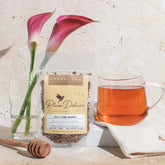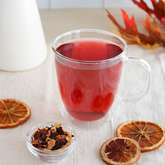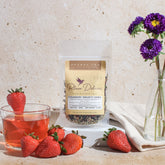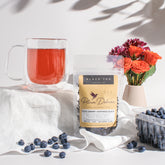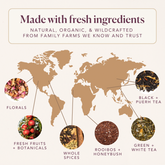But what does pu-erh tea taste like? And what makes it so unique compared to other loose leaf teas? If you’re new to the wonderful world of pu-erh, we’ll happily introduce you – just keep reading!

What Is Pu-erh Tea?
You’ve probably heard of aging drinks like whiskey, rum, and wine, but what about tea?
What counts as a “true” pu-erh has changed a bit in recent years, but the process remains the same: Pu-erh is a tea that’s fermented and aged, allowing it to develop unique, complex flavors that aren’t typical of other teas. There’s nothing quite like it!
What Does Pu-erh Tea Taste Like?
There are many flavors associated with pu-erh, and they depend on a few factors such as regional origin, age of the plant, and how long the tea has been aged.
You have “raw” pu-erh tea that has typically been aged for years and has more complex flavors. It tastes rich, dark, earthy, and sometimes bitter. As pu-erh ages, it becomes smoother, more mellow, and less bitter.
“Cooked” or “ripe” pu-erh is a bit more mild and smooth. It’s probably the most common kind of pu-erh here in the west and doesn’t have a lot of the strong, bitter flavors that might turn new tea drinkers off of it. It has the widest range of flavors, especially due to its growing popularity.
You’ll find even more tea blends made in the style of pu-erh (usually referred to as “dark tea”) that have rose petals and other additions compressed into cakes or other shapes.
If you ask tea drinkers what pu-erh tastes like, you’ll get a variety of answers. These include some pretty negative takes on the tea – fishy, mildewy, or even that it just tastes like a mouthful of dirt.
This isn’t typical of pu-erh and just means it wasn’t stored and aged properly. “Fishy” and other bad tastes come from the presence of undesirable microbes. Unfortunately, poor handling leads to poor aging and these flavors don’t just go away. (The good news? You won’t get this from reputable tea companies!)

How Is Pu-erh Tea Made?
Most pu-erh teas are processed similarly, but there are some slight variations.
First, tea leaves are picked and quickly dried (or dry-roasted) to help prevent oxidation. Then, the leaves are rolled, shaped, and left to dry in the sun. Lastly, the tea is pressed into raw pu-erh, which is then fermented and aged in storage.
Alternatively, pu-erh can be “cooked,” which imitates the aging process through piling, dampening, and turning leaves almost like you would in a compost pile. (Just, y’know, without all the extra scraps.) Microbes are introduced and tea is left to ripen. Temperature, humidity, and microbe control are incredibly important. Otherwise, you wind up with some of the bad flavors we talked about earlier. (Then it will taste like a compost pile.)
Once the process is through, the tea is pressed into cakes, sometimes with other additions like different tea leaves, flavors, and flowers or herbs. However, it’s not always pressed; sometimes pu-erh is also sold as a loose leaf tea.
This is a rather simplified version of how pu-erh tea is processed, but it outlines the key differences between pu-erh and other teas – namely microbial fermentation rather than just the oxidation process. (And if you want to learn more about other tea, you can check out this post on how Plum Deluxe teas are made!)

What’s the Best Pu-erh Tea to Start With?
You’ll probably just want to dip your toes in the water and get started with a ripe pu-erh tea. These are pretty easy to come by and most of your favorite tea companies probably carry a few blends of their own.
The important part is to buy from a company you’re familiar with; you don’t want your first experience with this awesome tea to be ruined by something that wasn’t fermented properly. (And trust me, no one enjoys a mouthful of river water.)
Plum Deluxe has a really nice pu-erh-style tea that makes a great introduction to this type of tea. Vanilla Rose Dark Tea Hearts were among my first ever Plum Deluxe teas. It's a ripe dark tea that has been mixed with rose petals and vanilla essence and compressed into little heart-shaped cakes for a rich and complex flavor that holds up to multiple re-steeps.

![Fall Tea Variety Pack [6-Pack Variety of Flavors]](http://www.plumdeluxe.com/cdn/shop/files/Fall_Tea_Variety_Pack.png?v=1754953749&width=165)


